lock CADILLAC DEVILLE 1997 7.G Owners Manual
[x] Cancel search | Manufacturer: CADILLAC, Model Year: 1997, Model line: DEVILLE, Model: CADILLAC DEVILLE 1997 7.GPages: 386, PDF Size: 21.61 MB
Page 10 of 386
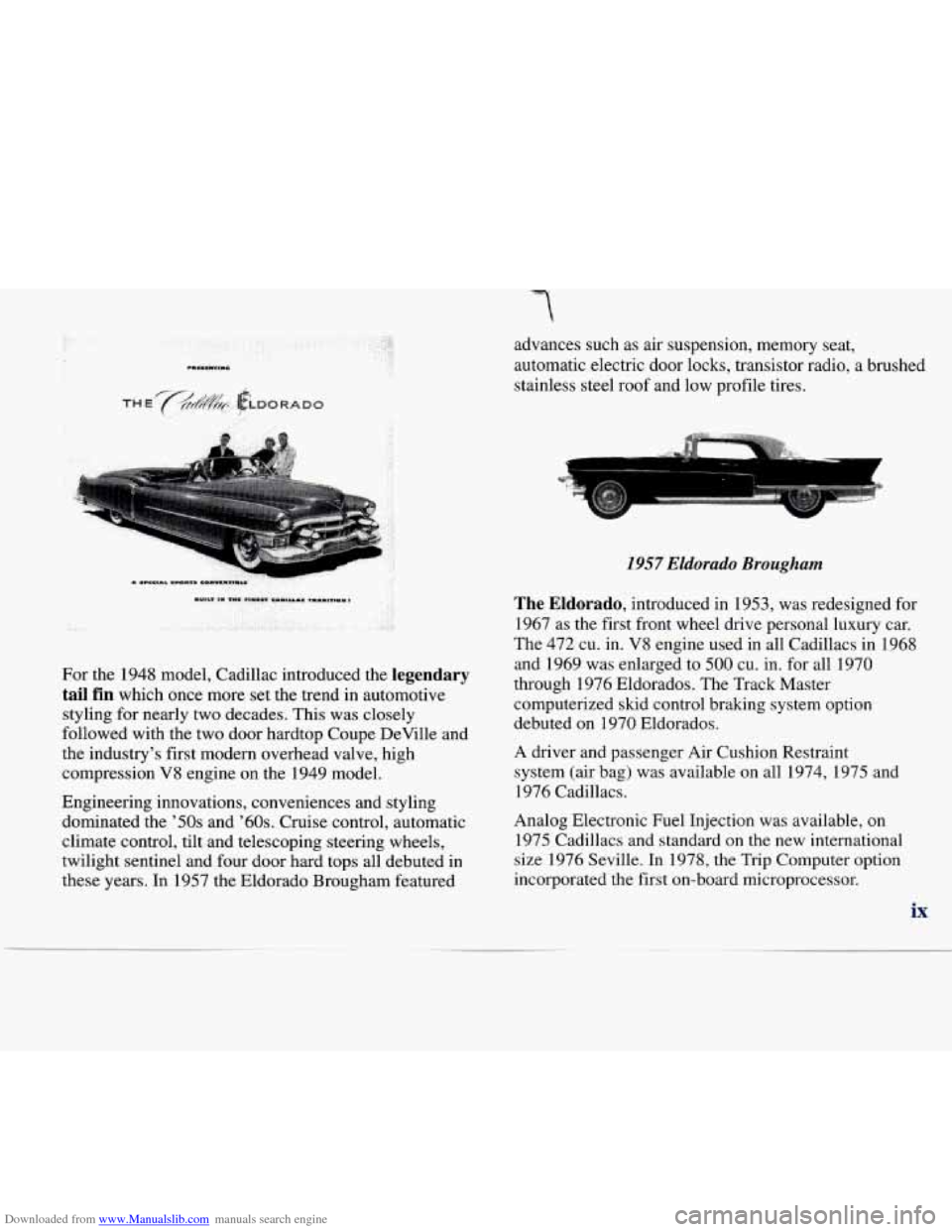
Downloaded from www.Manualslib.com manuals search engine For the 1948 model, Cadillac introduced the legendary
tail fin which once more set the trend in automotive
styling for nearly two decades. This was closely
followed with the two door hardtop Coupe DeVille and
the industry's first modern overhead valve, high compression
V8 engine on the 1949 model.
Engineering innovations, conveniences and styling dominated the
'50s and '60s. Cruise control, automatic
climate control, tilt and telescoping steering wheels,
twilight sentinel and four door hard tops all debuted in
these years. In 1957 the Eldorado Brougham featured advances such as air suspension, memory seat,
automatic electric door locks, transistor radio, a brushed
stainless steel roof and low profile tires.
1
I957 Eldorado Brougham
The Eldorado, introduced in 1953, was redesigned
for
1967 as the first front wheel drive personal luxury car.
The 472 cu. in.
V8 engine used in all Cadillacs in 1968
and 1969 was enlarged to
500 cu. in. for all 1970
through 1976 Eldorados. The Track Master
computerized skid control braking system option
debuted
on 1970 Eldorados.
A driver and passenger Air Cushion Restraint system (air bag) was available on all 1974,
1975 and
1976 Cadillacs.
Analog Electronic Fuel Injection was available, on 1975 Cadillacs and standard on the new international
size 1976 Seville. In 1978, the Trip Computer option
incorporated the first on-board microprocessor.
ix
Page 11 of 386
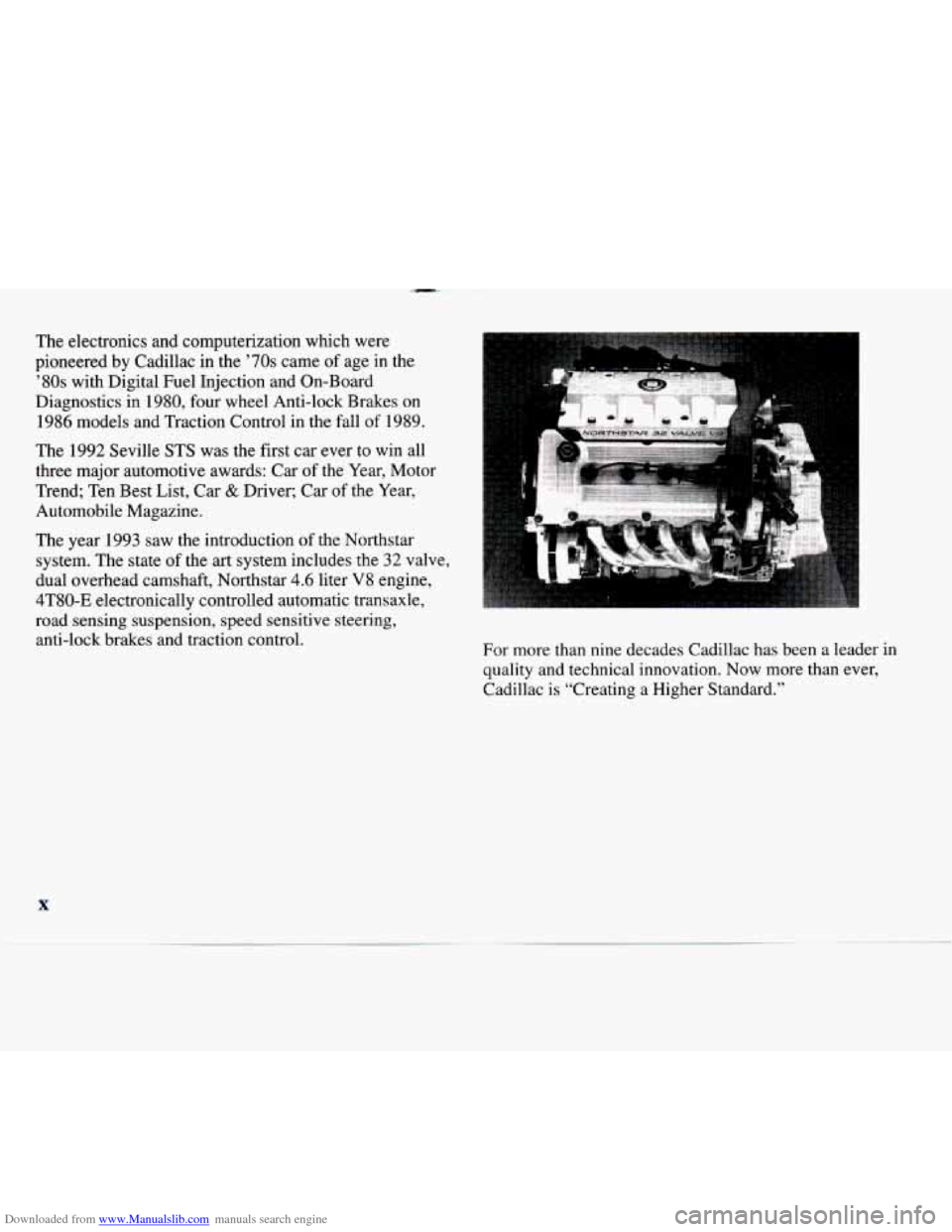
Downloaded from www.Manualslib.com manuals search engine a
The electronics and computerization which were
pioneered by Cadillac in the
’70s came of age in the
’80s with Digital Fuel Injection and On-Board
Diagnostics in 1980, four wheel Anti-lock Brakes on 1986 models and Traction Control in the fall
of 1989.
The 1992 Seville STS was the first car ever to win all
three major automotive awards:
Car of the Year, Motor
Trend; Ten Best List, Car
& Driver; Car of the Year,
Automobile Magazine.
The year
1993 saw the introduction of the Northstar
system. The state
of the art system includes the 32 valve,
dual overhead camshaft, Northstar
4.6 liter V8 engine,
4T80-E electronically controlled automatic transaxle,
road sensing suspension, speed sensitive steering, anti-lock brakes and traction control. For more than nine decades Cadillac has been a leader
in
quality and technical innovation. Now more than ever,
Cadillac is “Creating a Higher Standard.”
X
Page 14 of 386
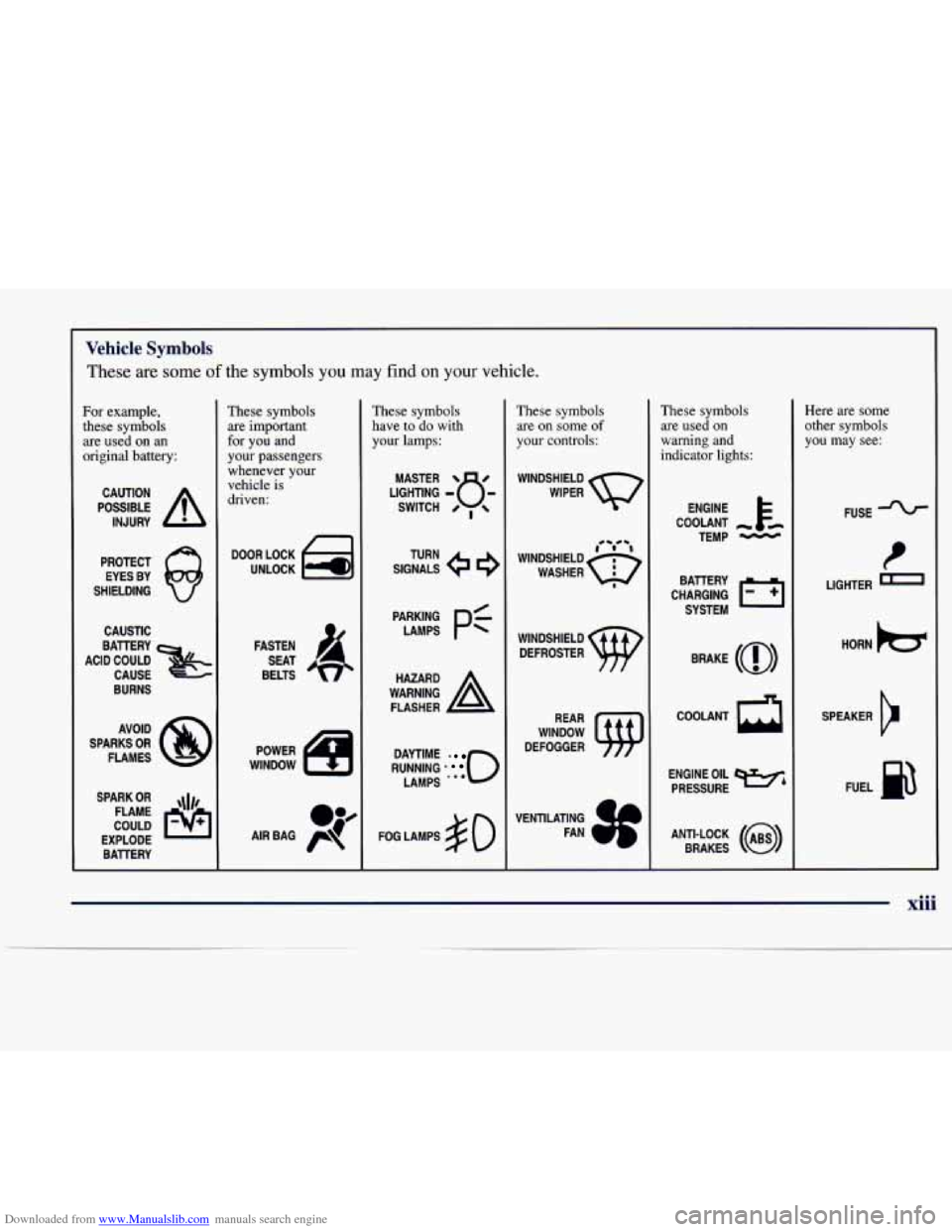
Downloaded from www.Manualslib.com manuals search engine Vehicle Symbols
These are some of the symbols you may find on your vehicle.
For example,
these symbols
are used on an
original battery:
POSSIBLE A
CAUTION
INJURY
PROTECT EYES BY
SHIELDING
CAUSTIC
BURNS AVOID
SPARKS
OR
FLAMES
SPARK
OR ,111,
COULD
FLAME
EXPLODE BATTERY
These symbols
are important
for you and
your passengers
whenever your
vehicle
is
driven:
DOOR LOCK
UNLOCK
FASTEN SEAT
BELTS
These symbols have to do with
your lamps:
SIGNALS e
TURN
WARNING
A
HAZARD
FLASHER
RUNNING
* 0
DAYTIME *
LAMPS *'*
FOG LAMPS $0
These symbols
are on some of
your controls:
WIPER Q
aa aa
WINDSHIELD
DEFROSTER
VENTILATING FAN
These symbols are used
on
warning and
indicator lights:
COOLANT
TEMP
-
CHARGING I-1
BAllERY
SYSTEM
BRAKE
(0)
CT
ENGINE OIL w,
PRESSURE
ANTI-LOCK
(@)
BRAKES
Here are some
other symbols
you may see:
FUSE
P
LIGHTER -
HORN h=r
SPEAKER
b
FUEL e3
xiii
Page 19 of 386
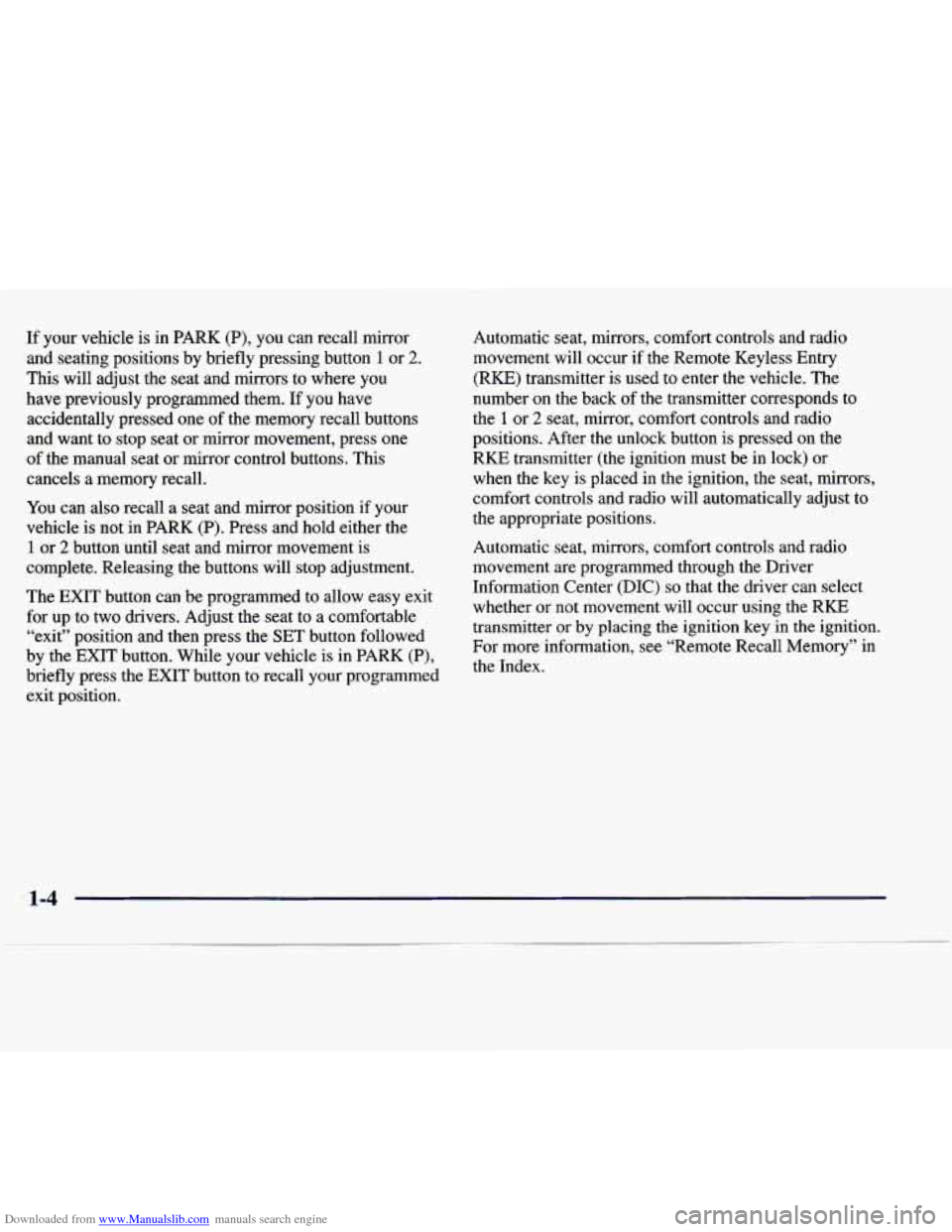
Downloaded from www.Manualslib.com manuals search engine If your vehicle is in PARK (P), you can recall mirror
and seating positions by briefly pressing button
1 or 2.
This will adjust the seat and mirrors to where you
have previously programmed them. If you have
accidentally pressed one
of the memory recall buttons
and want to stop seat or mirror movement, press one
of the manual seat or mirror control buttons. This
cancels a memory recall.
You can also recall a seat and mirror position if your
vehicle is not in PARK (P). Press and hold either the
1 or 2 button until seat and mirror movement is
complete. Releasing the buttons will stop adjustment.
The EXIT button can be programmed to allow easy exit
for up to two drivers. Adjust the seat to a comfortable
“exit” position and then press the
SET button followed
by the EXIT button. While your vehicle is in PARK (P),
briefly press the EXIT button to recall your programmed
exit position. Automatic seat, mirrors, comfort controls and radio
movement will occur
if the Remote Keyless Entry
(RE) transmitter is used
to enter the vehicle. The
number on the back of the transmitter corresponds to
the
1 or 2 seat, mirror, comfort controls and radio
positions. After the unlock button is pressed on the
RKE transmitter (the ignition must be in lock) or
when the key is placed in the ignition, the seat, mirrors,
comfort controls and radio will automatically adjust to
the appropriate positions.
Automatic seat, mirrors, comfort controls and radio
movement are programmed through the Driver
Information Center
(DIC) so that the driver can select
whether or not movement will occur using the RKE
transmitter
or by placing the ignition key in the ignition.
For more information, see “Remote Recall Memory” in
the Index.
1-4
Page 28 of 386
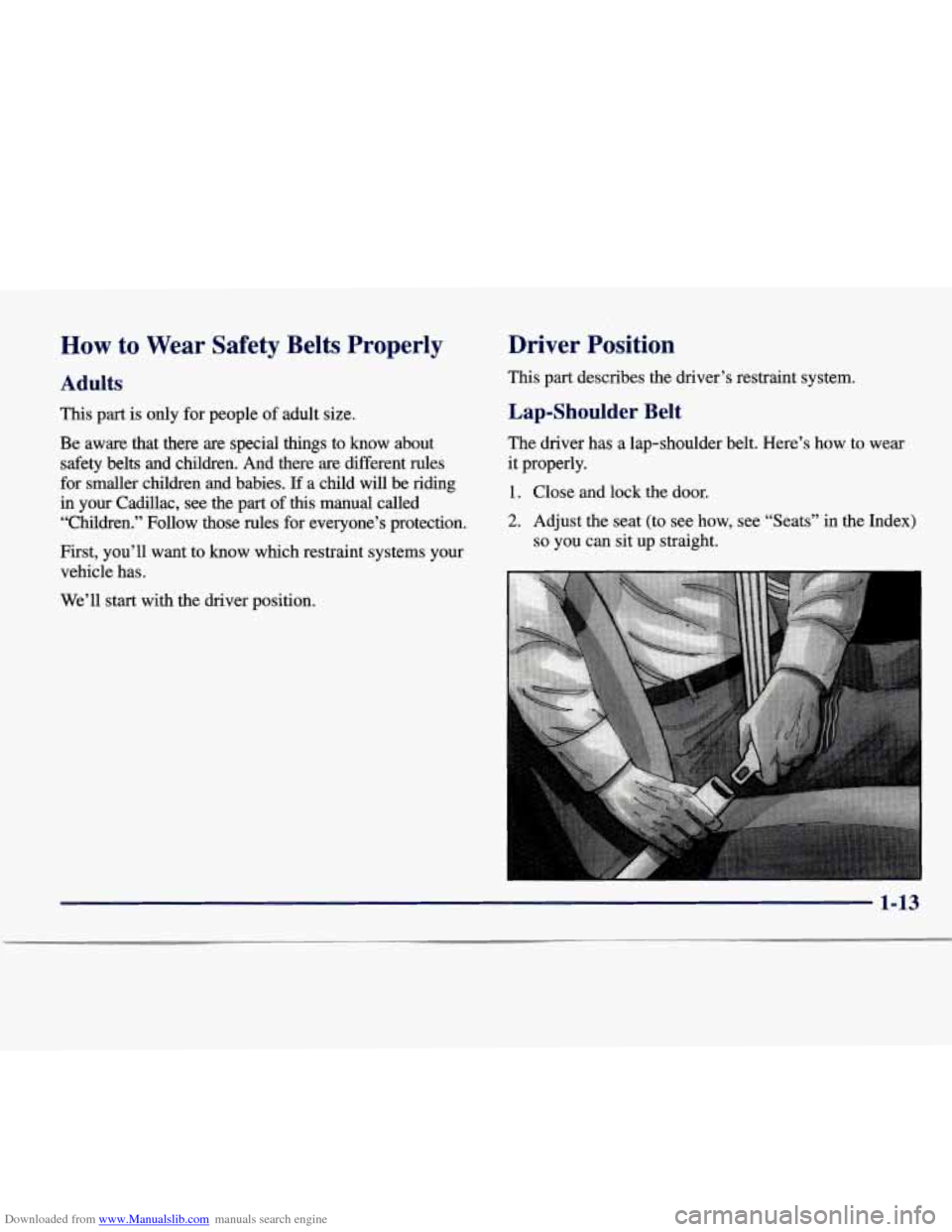
Downloaded from www.Manualslib.com manuals search engine How to Wear Safety Belts Properly
Adults
This part is only for people of adult size.
Be aware that there
are special things to know about
safety belts and chldren. And there are different rules
for smaller children and babies.
If a child will be riding
in your Cadillac, see the part of this manual called
“Children.” Follow those rules for everyone’s protection.
First, you’ll want to know which restraint systems your
vehicle has.
We’ll start with the driver position.
Driver Position
This part describes the driver’s restraint system.
Lap-Shoulder Belt
The driver has a lap-shoulder belt. Here’s how to wear
it properly.
1. Close and lock the door.
2. Adjust the seat (to see how, see “Seats’’ in the Index)
so you can sit up straight.
1-13
Page 29 of 386
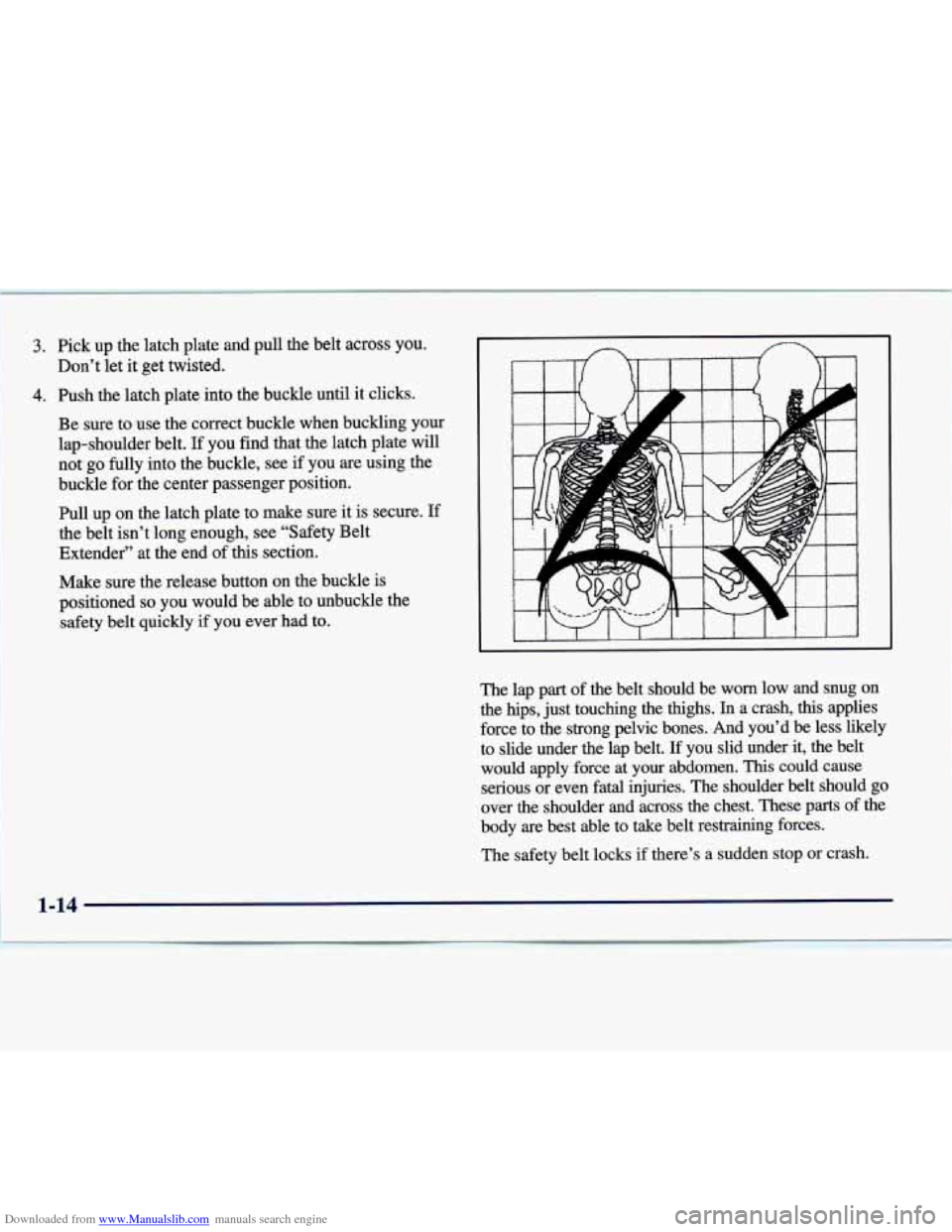
Downloaded from www.Manualslib.com manuals search engine 3. Pick up the latch plate and pull the belt across you.
4. Push the latch plate into the buckle until it clicks.
Don’t
let it get twisted. I
Be sure to use the correct buckle when buckling your
lap-shoulder belt.
If you find that the latch plate will
not go fully into the buckle,
see if you are using the
buckle
for the center passenger position.
Pull up on the latch plate to make sure it is secure. If
the belt isn’t long enough, see “Safety Belt
Extender’’ at the end of this section.
Make sure the release button on the buckle is
positioned
so you would be able to unbuckle the
safety belt quickly
if you ever had to.
The lap part of the belt should be worn low and snug on
the hips, just touching the thighs.
In a crash, this applies
force to the strong pelvic bones. And you’d be less likely
to slide under the lap belt.
If you slid under it, the belt
would apply force at your abdomen.
This could cause
serious or even fatal injuries. The shoulder belt should go
over the shoulder and across the chest. These parts of the
body are best able to take belt restraining forces.
The safety belt locks
if there’s a sudden stop or crash.
1-14
Page 30 of 386
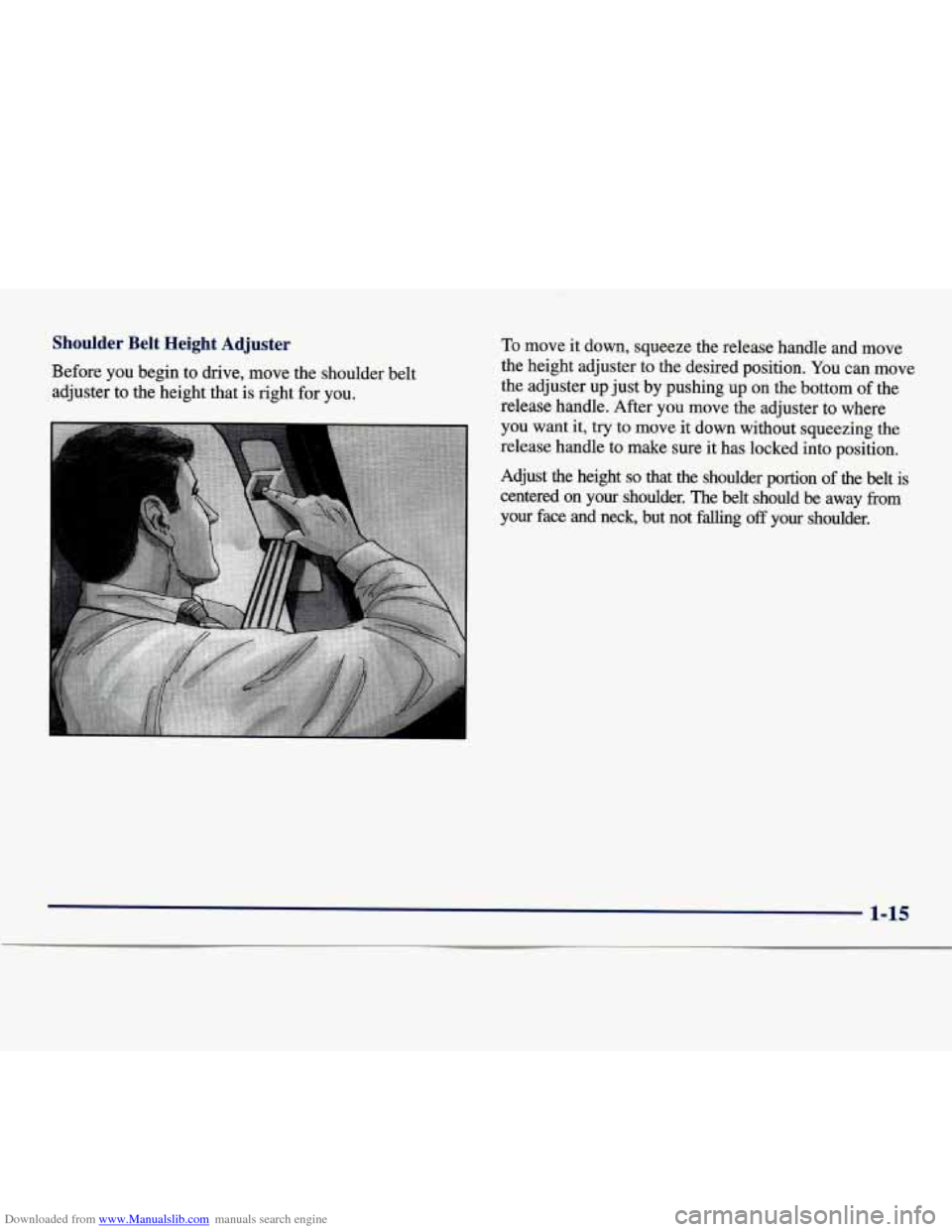
Downloaded from www.Manualslib.com manuals search engine Shoulder Belt Height Adjuster
Before you begin to drive, move the shoulder belt
adjuster to the height that is right for you.
To move it down, squeeze the release handle and move
the height adjuster to the desired position.
You can move
the adjuster up just by pushing up on the bottom of the
release handle. After you move the adjuster to where
you want it, try to move it down without squeezing the
release handle to make sure it has locked into position.
Adjust the height
so that the shoulder portion of the belt is
centered on your shoulder. The belt should
be away fiom
your face and neck, but not falling
off your shoulder.
1-15
Page 37 of 386
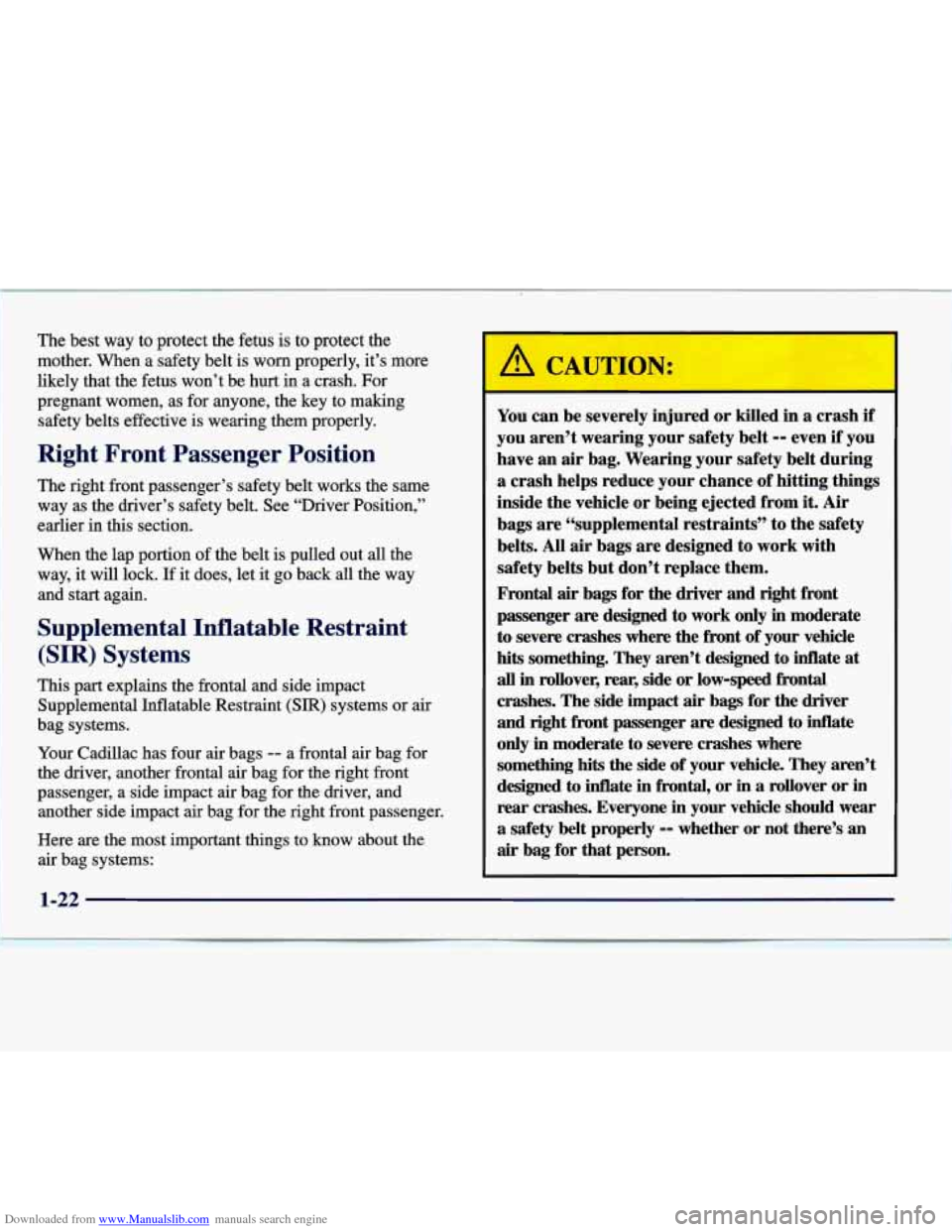
Downloaded from www.Manualslib.com manuals search engine The best way to protect the fetus is to protect the
mother. When a safety belt is worn properly, it’s more
likely that the fetus won’t be hurt in a crash. For
pregnant women, as for anyone, the key to making
safety belts effective is wearing them properly.
Right Front Passenger Position
The right front passenger’s safety belt works the same
way as the driver’s safety belt. See “Driver Position,”
earlier in this section.
When the lap portion of the belt is pulled out
all the
way, it will lock.
If it does, let it go back all the way
and start again.
Supplemental Inflatable Restraint
(SIR) Systems
This part explains the frontal and side impact
Supplemental Inflatable Restraint
(SIR) systems or air
bag systems.
Your Cadillac has four
air bags -- a frontal air bag for
the driver, another frontal
air bag for the right front
passenger, a side impact air bag for the driver, and
another side impact air bag for the right front passenger.
Here are the most important things to know about the air bag systems:
A --
You can be severely injured or killed in a crash if
you aren’t wearing your safety belt
-- even if you
have an air bag. Wearing your safety belt during
a crash helps reduce your chance of hitting things
inside the vehicle or being ejected from it. Air
bags are “supplemental restraints” to the safety
belts. All air bags are designed to work with
safety belts but don’t replace them.
Frontal
air bags for the driver and right front
passenger are designed
to work only in moderate
to severe crashes where the front of your vehicle
hits something. They aren’t designed to inflate at
all in rollover, rear, side or low-speed frontal
crashes. The side impact
air bags for the driver
and right front passenger are designed to inflate
only
in moderate to severe crashes where
something
bits the side of your vehicle. They aren’t
designed
to inflate in frontal, or in a rollover or in
rear crashes. Everyone in your vehicle should wear
a safety belt properly -- whether or not there’s an
air bag for that person.
1-22
Page 43 of 386
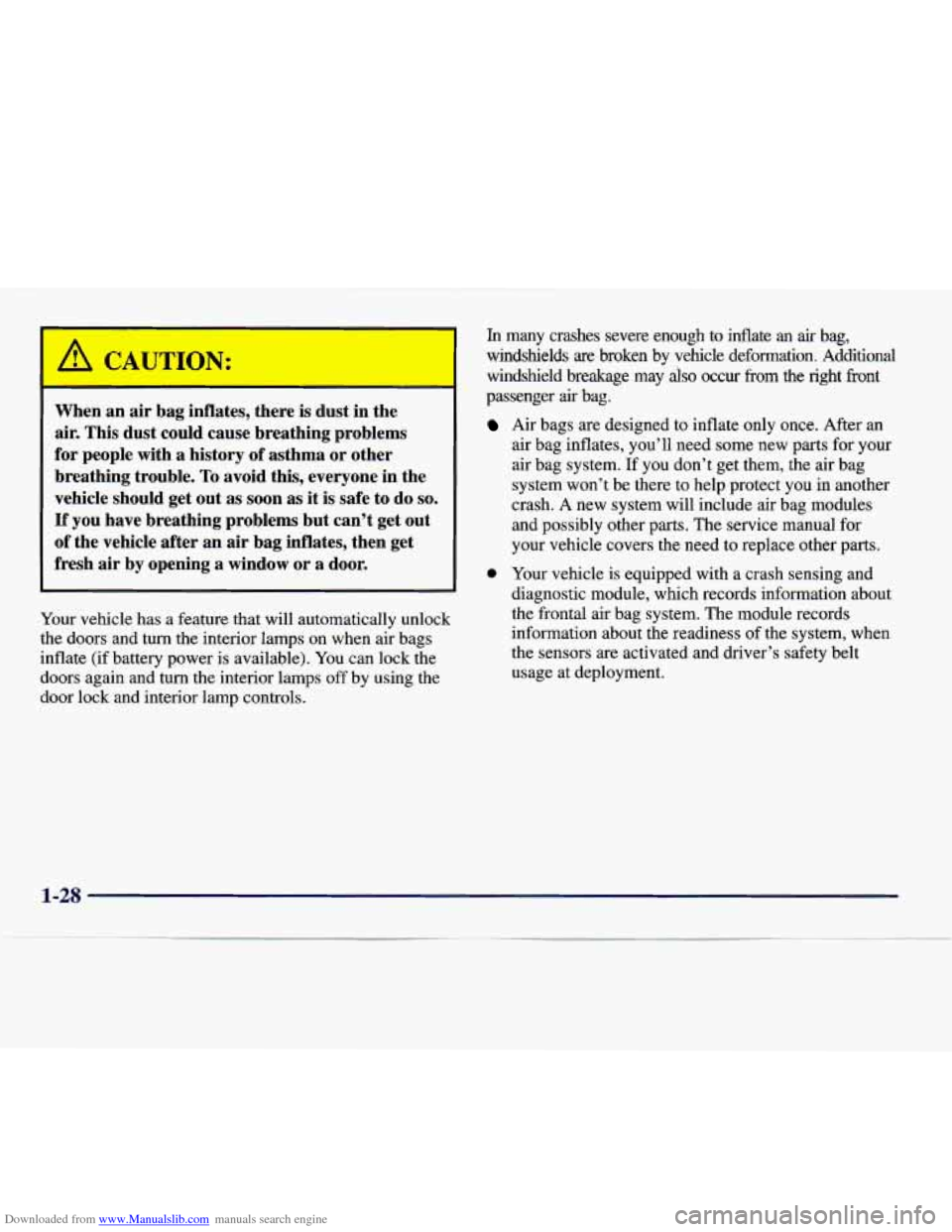
Downloaded from www.Manualslib.com manuals search engine A CAUTION:
When an air bag inflates, there is dust in the
air. This dust could cause breathing problems
for people with
a history of asthma or other
breathing trouble.
To avoid this, everyone in the
vehicle should get out
as soon as it is safe to do so.
If you have breathing problems but can’t get out
of the vehicle after an air bag inflates, then get
fresh air by opening a window
or a door.
Your vehicle has a feature that will automatically unlock
the doors and
turn the interior lamps on when air bags
inflate
(if battery power is available). You can lock the
doors again and turn the interior lamps off by using the
door lock and interior lamp controls.
In many crashes severe enough to inflate an air bag,
windshields are broken by vehicle deformation. Additional windshield breakage
may also occur from the right front
passenger air bag.
Air bags are designed to inflate only once. After an
air bag inflates, you’ll need some new parts for your
air bag system. If you don’t get them, the air bag
system won’t be there to help protect you in another
crash. A new system will include air bag modules
and possibly other parts. The service manual for
your vehicle covers the need to replace other parts.
0 Your vehicle is equipped with a crash sensing and
diagnostic module, which records information about
the frontal air bag system. The module records
information about the readiness of the system, when
the sensors are activated and driver’s safety belt
usage at deployment.
1-2s
Page 47 of 386
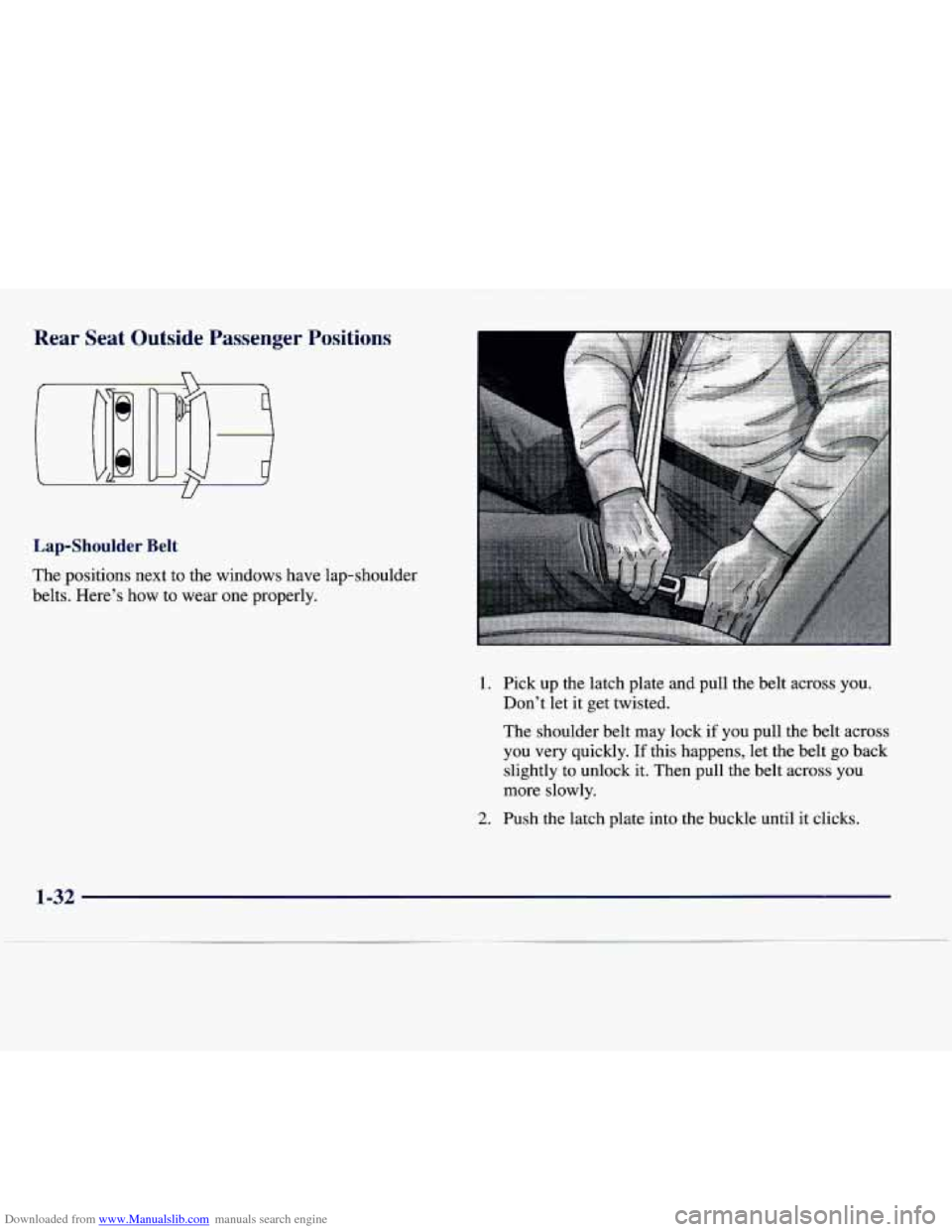
Downloaded from www.Manualslib.com manuals search engine Rear Seat Outside Passenger Positions
h
Lap-Shoulder Belt
The positions next to the windows have lap-shoulder
belts. Here’s how to wear one properly.
1. Pick up the latch plate and pull the belt across you.
Don’t let it get twisted.
The shoulder belt may lock if you pull the belt across
you very quickly. If this happens, let the belt
go back
slightly to unlock it. Then pull the belt across you
more slowly.
2. Push the latch plate into the buckle until it clicks.
1-32